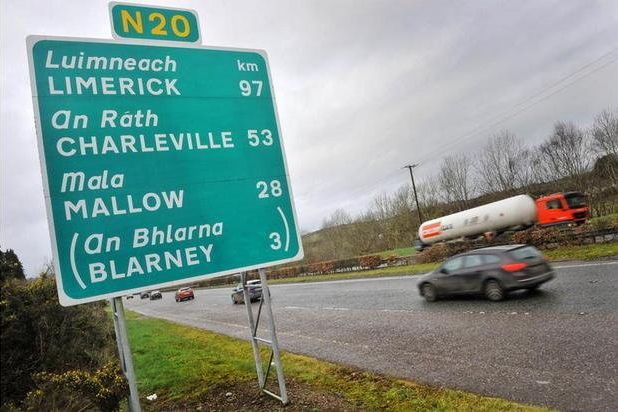World
€2bn Limerick-Cork M20 motorway with cycle lanes to be first of its kind in Ireland

Road would be the first to adopt distance-based tolls so that motorists pay according to how many kilometres they drive
The M20 would provide 80km of motorway but with more than a nod to public and active transport.
It would have cycleways all along it and six transport hubs to encourage motorists to “park and ride” on bus services, “park and share” with other car-poolers or “park and cycle” the last stretch to the nearest town.
EV and e-bike charging stations would be at all hubs and a seventh hub, dedicated to freight, would provide similar services as well as rest facilities for goods drivers.
If the facilities do not provide enough incentive to use alternatives to cars and diesel, the charges might.
The motorway would be the first to adopt distance-based tolls so that motorists pay according to how many kilometres they drive rather than a fixed fee.
Building it is expected to cost around €2bn. Construction of the motorway could start in 2027 and be finished by 2031.
Transport Infrastructure Ireland (TII) says the investment will be worth it because the existing N20 route linking the country’s second and third largest cities is over-capacity and dangerous.
TII says upgrading to motorway standard, even with a 120kmh speed limit, will make the route five times safer.
Transport Minister Eamon Ryan had argued against the motorway at the last election. Photo: Collins
It also says it will cut 30 minutes off journey times which, in congestion, can take anything from 90 minutes to two and a half hours.
The state roads agency also says bypassing Mallow, Buttevant and Charleville will allow the towns to enjoy reduced noise and air pollution, and better space to grow business and tourism.
With the addition of 80km of cycleways, the agency says there will be a total of 100km of active transport infrastructure between Blarney in Cork and Patrickswell in Limerick.
Extra bus services are promised to serve the transport hubs while new intercity express services would also be developed.
TII is also emphasising the economic importance of what it says would ultimately form an “Atlantic corridor” all the way from Cork to Galway.
The details were presented to public representatives at a closed meeting in Limerick today.
Limerick and Cork city and county councils will all be heavily involved in the project, which will have transport hubs at Rathduff, Mourneabbey, Buttevant, Charleville, Bruree and Croom. Mallow will host the freight hub.
The next steps will be public webinars on July 3 and 10, ongoing environmental surveys and a further public update by next spring followed by submission for Government approval and planning permission.
A need for a motorway between Cork and Limerick was first identified in 1998 but preliminary works stalled in the recession of the 2000s.
It came back on the agenda prior to the last election but Transport Minister Eamon Ryan cautioned against it, saying the cost, which he feared could reach €3bn, would be better spent on public transport.
The project has been politically sensitive, however, and Mr Ryan has been outnumbered by his senior government partners in getting it into the National Development Plan.










